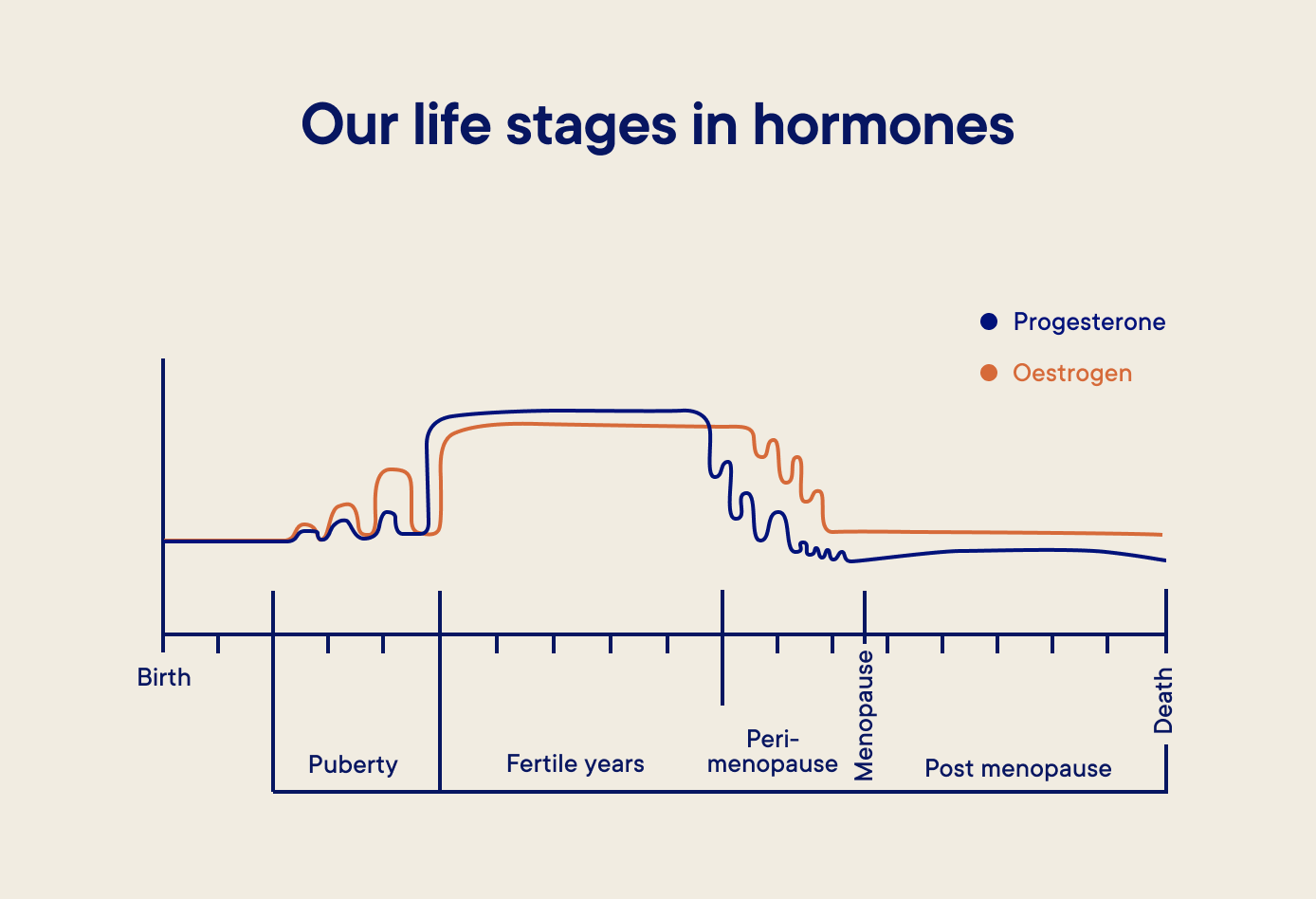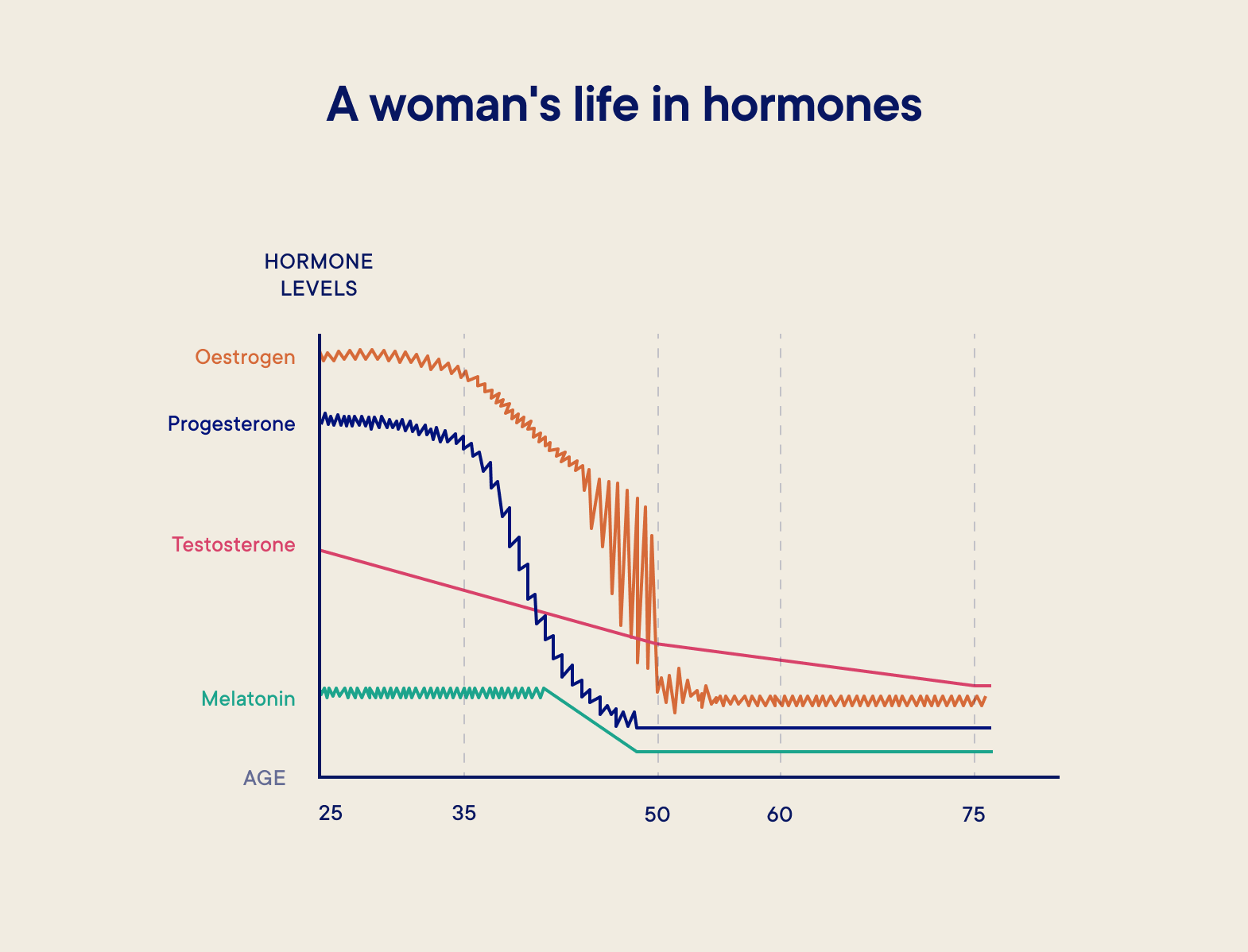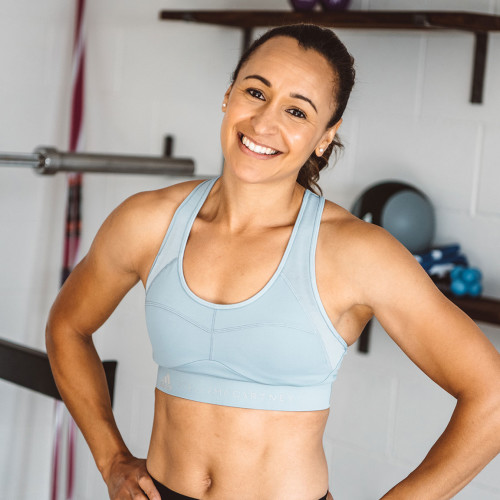The ultimate guide to fitness and exercise during perimenopause
a year ago
Perimenopausea year ago
Perimenopause
Is the exercise you used to do no longer having an impact? Have you lost your mojo to move? Trying to lose weight, but nothing working? Or maybe you keep getting injured? Whatever your fitness conundrum, we’ve got you covered, thanks to perimenopause fitness coach, Baz Moffat; physiologist, Dr Emma Ross and Jennis founder, Jess Ennis-Hill
Reviewed by: Baz Moffat, Dr Emma Ross and Jess Ennis-Hill
If you’ve hit perimenopause and you feel like your body isn’t responding to movement in the way that it used to, then we’re here to tell you that you can feel strong, confident and in control again. You just need to work with your body in a completely different way, quite simply because your body and hormones have changed.
Here, we discover what’s happening hormonally, then share the perimenopause fitness principles that will change the way you look at your workouts forever.
“When you go into perimenopause, you've essentially gone from having a lovely, natural cycle that's kind of predictable and inevitable in its four-phase pattern (see graphic 1 below) to being slightly more chaotic, with an overall decline in both oestrogen and progesterone,” explains Jennis physiologist, Dr Emma Ross.

That hormone chaos shows up in women in lots of different ways, with hundreds of reported symptoms , from anxiety to night sweats to difficulty shifting belly fat.
“I think a good way to look at perimenopause is that it’s kind of the opposite of puberty,” says Baz Moffat, perimenopause health coach.
“If puberty is your hormones getting themselves ready to have a regular cycle, with your hormones often quite erratic in the lead-up to that time, perimenopause is the time when your hormones are slowing down and you’re getting ready to stop having your cycle.” See graphic below.

Rather than simply switching off oestrogen, there’s an overall decline, with massive peaks and troughs of both progesterone and oestrogen on its way down. It’s these peaks and troughs that give rise to the main perimenopause symptoms. (Read about the top symptoms and what you can do about them, here .)
When you go through puberty, only 50% of your cycles will lead to an egg being released – and it’s exactly the same when you are perimenopausal.
Because we haven't got as many healthy eggs, we don’t mature and release them (this is an anovulatory cycle). “The brain doesn't know this,” reveals Dr Emma, “so sends more and more signals down to the ovaries to try and nudge an egg out, which creates a situation where you have a spike in oestrogen.
If there’s one single thing that I would tell you to add to your life as a perimenopausal woman, it would have to be strength and conditioning work
“Once your brain cottons on to this, it crashes the oestrogen levels and it’s this crash - in addition to the overall trending decline of hormones - that causes symptoms.”
The only reason that we produce progesterone is because we ovulate, so for anovulatory cycles (where no egg is released), no progesterone will be produced. “If you do have an ovulatory cycle, the overall levels of progesterone that you produce are probably declining anyway, which can contribute to you feeling differently,” says Emma.

The final important piece of the perimenopause fitness puzzle surrounds the stress hormone cortisol, which has an important impact on the way our body adapts to exercise, especially during perimenopause.
It’s probably no surprise, but most women in perimenopause are often highly stressed – physically, practically, emotionally and personally…
1) PHYSICALLY // Perimenopause, like puberty, is a stressful state for the body
“Because you are experiencing the peaks, troughs and general decline of the main menstrual cycle hormones, your body is in a stressed state and becomes inflamed as a result,” says Baz.
2) PRACTICALLY // Life is FULL ON
“Most women during perimenopause have A LOT going on,” says Baz. “They often have busy, stressful jobs and lives. They are often juggling the needs of lots of family members - whether that’s kids, parents or both. And it’s often a time when our key relationships change – whether that’s divorce, children leaving the nest etc.”
That means that lots of women in this life stage are experiencing lots of external stressors that can contribute to internal stress and high levels of cortisol.
3) EMOTIONALLY // Symptoms add to anxiety
The symptoms that come with perimenopause include a change in cycle, hot flushes, lower libido, higher irritation and so on. “All these things, along with a sense that you don’t know what is happening to you, can contribute to stress and feeling out of control,” says Dr Emma.
4) PERSONALLY // We don’t prioritise ourselves
For many women, time / life / work pressures over the past decade have meant that they haven’t prioritised themselves, their physical and mental health or the things that bring them joy, which means they don’t have the strategies to deal with cortisol.
“Simple things, like making time for mindfulness or taking time out for you, feel indulgent, when it should really be prescribed,” says Jennis founder, Jess Ennis-Hill.
If you’ve been stressed for years, possibly decades, ‘why does it matter now?’, we hear you ask.
“In the context of fitness and exercise, if you're in this inflammatory state as a result of entering perimenopause,” says Baz, “when you add more stress to the system, such as hardcore exercise or calorie / carb-restricted diets, you create more stress.”
Simple things, like making time for mindfulness or taking time out for you, feel indulgent, when it should really be prescribed
Because there's so much cortisol being produced, the body can't process it. “Chronic high levels of cortisol affect your metabolism and your appetite, resulting in weight gain, particularly fat around the middle - and thats when some women get middle-aged spread,” says Emma.
“I’m hoping this is music to women’s ears,” says Baz. “Rather than training harder, restricting yourself of more and more calories and stressing your body even more, actually, what we need to do is down-train, tap into the parasympathetic nervous system to manage the cortisol levels and work on changing body composition, so there’s more muscle than fat.”
That doesn’t mean you can’t do endurance sessions or do the things you love. It just means that you have to manage your sessions so that you get the physical benefits without spiking that stress hormone.
“By doing this, you sleep better, you eat better, you get the results you want - and it has a positive knock on effect on your whole life,” agrees Jess.
1) DO: A flowing warm-up Because we’re more prone to injury during perimenopause, it’s really important to do a really nice and flowing warm-up for at least 10 minutes before you start any runs, HIIT sessions or any other vigorous activity. “Where you used to be able to skip this in your 20s, for long-term health and fitness, you really don’t want to avoid your warm-ups,” says Baz.
Not only does it prepare your muscles for what’s to come, but it also tells your nervous system that you’re getting ready to go, rather than shocking your system and kick-starting a stress response.
2) DO: Get smart with hydration
With stress management front of mind when it comes to perimenopause fitness: “If you know that you’re going into a hard session,” says Baz, “it’s important to make sure you hydrate properly beforehand so that you don’t stress your body out even more.”
The same is true post-workout, says Jess. Even if you’re going straight back to your desk after a workout, make sure you drink water, rather than going straight for the caffeinated beverages to help your system wind down and replenish.
3) DO: Up the strength and conditioning
“If there’s one single thing that I would tell you to add to your life as a perimenopausal woman,” says Baz, “it would have to be strength and conditioning work. There are just so many reasons why it’s beneficial and good for health at this lifestage.
As we get older, our muscle mass decreases by 3-8% per decade over the age of 30 . “By working with weights or adding carefully constructed HIIT sessions that feature bodyweight resistance exercises, you can help to maintain or increase your muscle mass,” says Jess. Plus, you can alter your body mass composition, so that you reduce fat percentage in favour of muscle.
When it comes to injury prevention, which we mentioned can be an issue for women at this life stage, strength training can help to prevent injuries by strengthening the muscles around your joints, while also contributing to bone health.
Women who have more muscle than fat will have reduced hot flushes by up to 70%
“The other reason why strength training is so good is that it produces a better metabolic reaction in terms of calories burnt, plus calories burnt after you stop working out (also known as Excess Post Exercise Consumption or afterburn),” says Baz.
When it comes to mental health and symptom management, strength training also comes up trumps. According to numerous studies , strength training has been shown to reduce anxiety and stress levels and improve depression and stress.
In a recent study by Dr Rosanne Woods , it was also concluded that women who have a higher lean body mass, which essentially means more muscle than fat, will have reduced vasomotor symptoms (hot flushes) by up to 70%.
4) DO: Incorporate pelvic floor work
Whether you have or haven’t had children, it’s important to start incorporating pelvic floor work into your exercise routine because of the effect of declining oestrogen on the vagina.
There are oestrogen receptors all over our body and the vagina, specifically, is very dense in terms of the oestrogen receptors. When oestrogen starts to decline, many women will experience vaginal dryness and vaginal atrophy, which can impact lots of areas of life, including confidence exercising.
Whenever you push yourself and your body, you need to leave time to wind down physically and hormonally so that you don’t add stress to your system
“At the moment, the issue of a woman’s pelvic floor is very much in the hands of women's health physiotherapists and gynaecologists - and usually only becomes a discussion point once the problem has become quite bad,” says Baz. “I really feel that it should be tackled in an exercise setting so that awareness is raised much earlier and women put in place preventative measures.”
For Baz, that means that every workout session you do should have two minutes of pelvic floor work, “not because you've got a problem, but because this gives you an insurance policy and an awareness of what's going on down there.”
5) DO: Exercise your body and brain
Brain fog is another common symptom of the perimenopause - and yet again, exercise can help.
“If you can connect mental acuity skills with physical activity, you see a much bigger improvement,” says Baz.
“That’s why sports such as netball, tennis and badminton, are really good for you,” says Jess. “Fitness and strength classes that combine music and motion also help to keep you sharp physically and mentally.”
6) DO: Follow hard exercise with smart de-stress strategies
When it comes to how hard you push your fitness, it’s ok to go hard with your HIIT sessions; to do that long endurance run or to really sprint at the end of the ParkRun. But whenever you push yourself and your body, you need to leave time to wind down physically and hormonally so that you don’t add stress to your system.
“If you’re doing a Jennis workout at home, that could mean doing a longer cool-down or adding a quick breathwork session to tap into the calming effect of the parasympathetic nervous system. If you’re doing a fitness class in the gym, you might want to think about walking home afterwards, rather than jumping straight in the car,” advises Baz. “Anything that helps to wind you back down after you have ramped your system up.”
We mentioned this earlier, but it’s important to say it again. “For many perimenopausal women who want quick physical results, the tendency is to hit the gym hard, avoid all the carbs and go on a calorie restricted diet,” says Baz.
“But, if you're not eating; you’re running more than ever and you've got high cortisol, it can make your perimenopausal symptoms and the belly fat you’re trying to get rid of worse because you’re adding stress to an already stressed system.”
So, definitely do exercise. But make sure you sandwich smart de-stress techniques around the things you like to do. And don’t deny yourself food. Just eat sensibly, rather than restricting yourself.
A lot of mid-life women who have stressful jobs and busy days often turn to a glass of wine in the evening (and the Jennis team are no different). “I’m not saying that you should stop drinking all-together,” says Baz. “But it’s worth tracking your symptoms relative to one or two drinks a night.” Because you’re in an inflammatory state, for a lot of women, even just one glass at a night can cause symptoms and disrupt sleep. And that disrupted sleep can have a knock-on effect to your exercise commitments, the quality of food you eat, the amount of caffeine you need the next day and so on.
You need to remove the non-essential ‘junk runs’ and replace them with strength and conditioning sessions
“I speak to a lot of perimenopausal runners and particularly marathon runners who are very fixed on running five or six days a week,” says Baz.
“For these women, I say: you can train hard, you can train really hard. But you can no longer ignore all the stuff that you've been told how to do since you were 20.
“So, you can absolutely do a hard running session, but you have to make sure that you've warmed up properly and that you're well hydrated when you go into that session. Then you need to cool down properly, relax your system and have a good quality sleep.
For these women, it’s also about removing the non-essential ‘junk runs’, as Baz calls them, and replacing them with strength and conditioning sessions, which probably take a lot less time.
“Rather than run, run, run, every session has to count for something. By replacing just two of those weekly runs with strength or conditioning sessions, you’re actually helping your body and you’ll also find that it improves your running performance.”
The good news is that if you understand what’s happening to your body during perimenopause, you can tailor your movement to complement the changes taking place, rather than making your symptoms worse.
You can get to where you want to be, plus you can feel good about yourself on the way there.
 Cycle syncing
Cycle syncing Perimenopause
Perimenopause Perimenopause
Perimenopause Perimenopause
PerimenopauseSign up to learn everything you need to know about CycleMapping, plus how you can live better and feel better through optimising your fitness to you.
This website uses cookies to ensure you get the best experience on our website. Learn more

Sign up for the very latest news on women's fitness, health and hormones, plus be the first to receive exclusive offers and extras